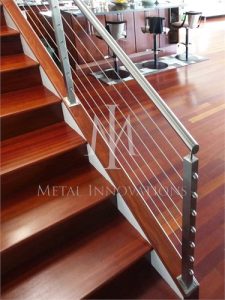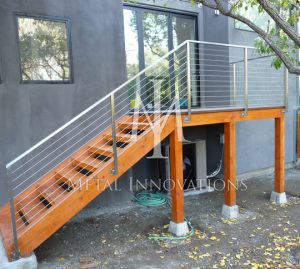A cable railing is a reliable safety guardrail assembly that you can install in various outdoor and indoor spaces, such as decks and balconies. Cable railing systems are a sleek and modern alternative to conventional wood railings and offer unobstructed views. The best part? They are low-maintenance and can be a cost-effective option.
Keeping this in mind, you have to consider structural requirements, project location, material options, cost, and building code compliances to ensure a smooth and safe cable railing installation. Understanding these elements and variables will help you avoid problems and make the most out of your project.
But when it comes to installation, there are two choices: DIY or professional. Choosing the right cable railing installation method can be tricky, but don’t worry – we’re here to guide you towards the perfect solution for your cable railing installation needs.
What is Cable Railing?
Cable railing, also known as wire rope railing, has become a popular alternative to traditional wood guardrails. Imagine replacing bulky and unattractive wooden balusters with taut, slender cables that offer unobstructed views and a minimalist aesthetic. That’s the essence of a cable railing! It’s not just about safety; it’s a statement piece, adding a fresh, minimalist aesthetic to decks, staircases, balconies, and other areas.
Understanding the Cable Wire Railing Components
Cable wire railing components or parts are essential for creating stylish and safe cable railing systems for your home or other property. What are these components typically made from? Usually stainless steel –this ensures durability and resistance to various elements. Before exploring the pros and cons of DIY vs. professional cable railing installation, let’s familiarize ourselves with the main components of a cable railing system:
Posts
These support the whole railing system and come in various materials. Wood, metal, and composite, to name a few!
Top Rails
These tend to run horizontally along the top of the posts and can be made of wood, metal, or cable.
Cable
This is the tensioned element that runs between the posts and provides the railing’s main support.
Surface Mount Fittings
These are often suitable for railing installations where the cable is mounted directly to the wall or other surfaces. Surface mount fittings offer a clean, chic, and modern look for the railing system.
Hardware
This includes tensioners, swages, and other fittings that help connect and secure the posts and cables.
What is the Cable Railing Installation Process?
Before you grab your toolbelt and equipment, let’s understand the key steps involved in cable railing installation. There are various options that can be fitted by both professionals and DIY enthusiasts. A popular look includes steel frames and industrial styling, ideal for people who want a contemporary theme. This process may seem complex, but understanding each stage will help you assess your skills and decide if tackling this project yourself is the right choice. Here are the steps.
Layout and Planning
Before starting, you should carefully plan the layout of your cable railing system, including the location of balusters or posts, top rail tubing, and cable routing. Measure and mark the post locations, ensuring proper spacing and alignment (e.g., 4 feet maximum apart).
Gather Necessary Materials and Tools
You’ll need appropriate tools and parts, such as wire cutters, a cable cutter, and a tensioner. Additionally, gather all the cable railing components.
Post Installation
Now, it is time to secure the posts to the balcony or deck using appropriate foundation anchors.
Top Rail Installation
You can attach the top rail to the posts, following the manufacturer’s instructions. Make sure that the top rail is installed adequately before installing the cables.
Cable Installation
Thread and run the cable through the posts and tension it using the hardware provided. Also, use your cable cutters to cut any wire excess.
Clean Up
Clean any debris from the handrail brackets and post-mounting area. You can also inspect the installation for any potential issues.
DIY Cable Railing Installation
No doubt, DIY cable railing installation has some benefits, such as affordability. However, also consider the drawbacks before deciding which option is right for you.
Pros
- Cost-effective – You can save money on labor costs by installing the railing yourself. The cost of installing a cable railing yourself is around $30 per foot for labor, while the cost of materials for a 10-foot railing can range from $110 to $380.
- Sense of accomplishment – Successfully completing the railing project yourself can be rewarding.
- Customization – You’ve more control over the design and materials used.
Cons
- Time commitment – Installing cable railings can be time-consuming, especially if you’re not experienced. This is also true for longer installations. Be prepared to invest several hours in the projects.
- Technical skills required – You need basic carpentry and DIY skills in order to handle the installation properly and safely.
- Risk of errors – Mistakes during planning or installation can compromise the safety and integrity of the railing. Cable railings are safety devices, and inadequate installation may lead to accidents.
- Weather and site conditions – Extreme weather and site conditions may affect outdoor cable railing installation projects, which can extend the project timeline or/and require additional materials.
- Warranty limitations – Some railing manufacturers may void their warranty if you don’t engage a professional and install the railing yourself.
Professional Cable Railing Installation
Professional railing installation offers numerous benefits and conveniences, such as cable railing safety and integrity, which make it worth the investment. Here are some benefits.
Pros
- Expert Workmanship – Professionals have the skills, expertise, and experience to ensure a safe and secure installation. Plus, you will receive guidance on the best materials or design options for your specific needs.
- Time-saving – They can get the job done efficiently and quickly because they have the tools and equipment to ensure a smooth and efficient installation process.
- Quality – Professional installers use top-quality materials and components, ensuring a durable and long-lasting installation. Also, you will benefit from maintenance and repair services that keep your cable railing system in top condition.
- Warranty Protection – Professional installation usually comes with a warranty on both materials and labor.
- Peace of Mind – Professional installers and technicians prioritize safety and can identify potential hazards and pitfalls during the installation process. You can rest assured that your railing is installed correctly and meets all safety standards.
Cons
- Higher cost – Hiring professionals will add to the overall project cost.
- Limited personalization – You may have less freedom or control over the design and materials used.
- Less hands-on involvement – If you enjoy hands-on projects and want to actively participate in the installation, hiring professionals may mean less direct involvement.
Which Way Should You Go? DIY or Professional?
The decision ultimately depends on the type of railing, your budget, skills, project complexity, and comfort level. If you’re a handy and savvy DIYer with the time and basic skills, tackling the cable railing installation yourself can be a cost-effective and rewarding option.
Similarly, DIY cable railing installation is much easier if you have worked on some home DIY projects in the past. However, if you prioritize code compliance, safety, warranty protection, and a hassle-free experience, hiring a professional installer is the way to go.
Summing Up
Cable railings provide a stylish, elegant, and functional option for decks, balconies, and other outdoor spaces. Whether you take the DIY route or choose professional installation, do your research and choose high-quality materials. If you are looking for cable railing installation in Southern California, you can rely on Metal Innovations to get the job done efficiently and safely. Contact them today at 800-641-6050 for a free consultation.
FAQs
How can I maintain my cable railing system?
Regular cleaning with mild soap and water, plus yearly tension checks, keeps your system sparkling and secure.
Do I need special tools to install the cable railing?
Some systems may require specialized tensioning tools, while others don’t. Check the requirements of your chosen system.
Can I customize the look of my cable railing system?
Absolutely! Choose post materials, cable spacing, and even add glass panels for a personalized touch.









 (800) 641-6050
(800) 641-6050